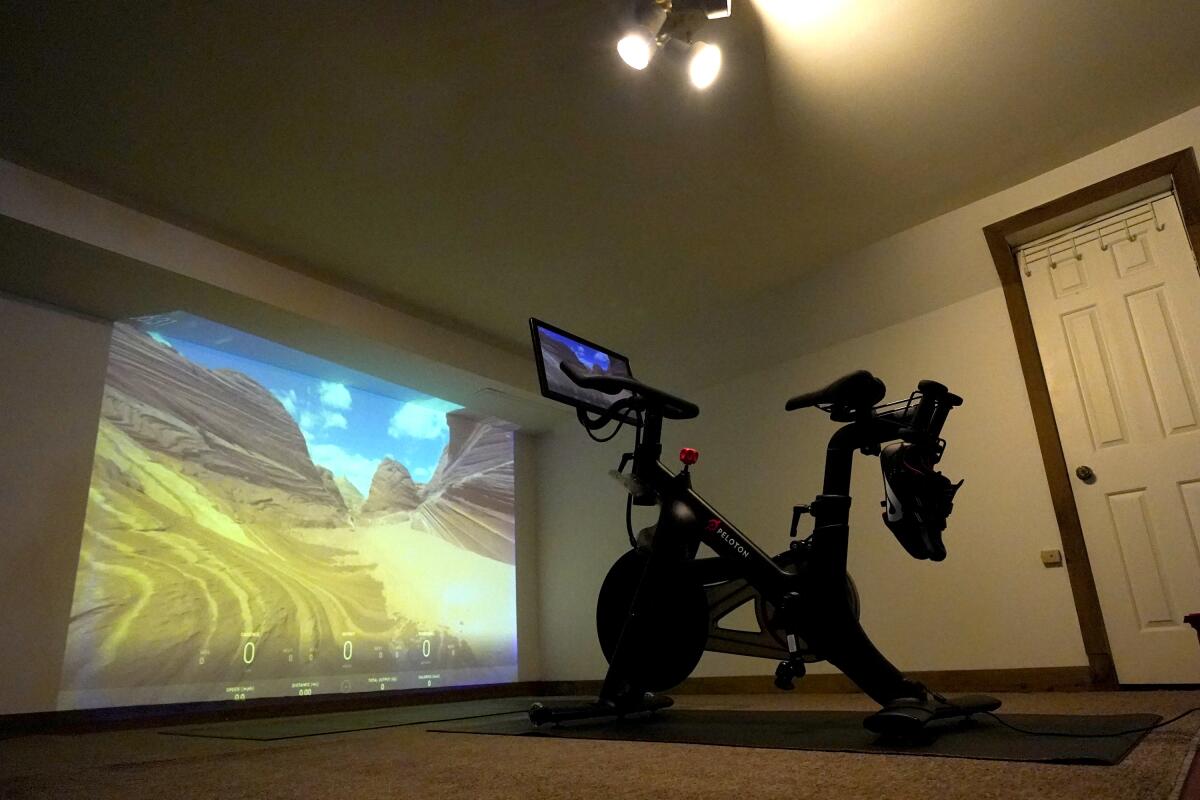L.A. cycling studios are reopening. Can they pry people away from their Peloton bikes?
- Share via
Vanessa Hicks bought her Peloton bike in November. Her COVID-19 diagnosis came a week later. Her pneumonia diagnosis came a month after that.
“The doctors said they weren’t sure if my lungs would ever get fully better,” said Hicks, 35, who served in the Navy from 2003 to 2007 and ran 30 half-marathons before the pandemic put an end to her traditional workout routine. “I was like, ‘Nah. I don’t accept that diagnosis.’”
Stuck inside, she hopped aboard her Peloton to rehabilitate her lungs and this month hit her 100th ride — an emotional century-mark that encompassed high-intensity workouts, tear-filled motivational rides and a community of Peloton enthusiasts that she virtually high-fived along the way.
Hicks, a lifelong gymgoer, represents a growing group of at-home fitness enthusiasts that gyms are hoping to lure back post-pandemic from Peloton, the maker of tech-savvy bikes whose stock price rose by nearly 500% while everyone was stuck inside last year. But she’s not sure she’ll ever go back.
On Monday, Los Angeles County loosened restrictions on a variety of indoor venues including restaurants, movie theaters and workout facilities. Gyms and cycling studios can now operate at 10% capacity, giving a small bit of relief to an industry reliant on close-quarters, in-person training that was slammed by lockdown orders last March.
However, some cycling studios say 10% capacity is putting a Band-Aid on their bullet wound.
Tatyana Fox is the owner of Bespoke, a cycling studio in downtown L.A. whose 20 employees have been out of work for the last year. The trendy spot has 39 bikes, so 10% capacity would be four riders.
“I’m not even sure if I can cover the instructor’s pay with four bikes. I have to pay staff, electricity and my landlord, so at least 25% capacity would be the only thing that makes sense,” said Fox, who hasn’t been able to pay the $12,000 monthly rent, piling up a debt of nearly $150,000 since she closed the studio last March.
Cost is one thing, but safety is another.
Fox said it’s dangerous for someone to wear a mask while doing intense cardio because the heart rate spikes and the lungs don’t get as much oxygen through a mask. When city officials allowed her and other studios to open for a few weeks in June, she bought a defibrillator — just in case.
“It’s devastating. I invested half a million into this business, and I can’t sell it or operate it,” Fox said. “Peloton is $39 a month. How can you compete with that?”

Peloton bikes start at $1,850, and newly released treadmills start at $2,495. From there, users pay $39 a month for a membership that includes a library of classes, instructors and individual profiles with curated playlists, personal challenges and community leaderboards.
When gyms closed, Peloton thrived. Shares of the publicly traded fitness company began 2020 at $27 and ended the year at $151.72, a leap of nearly 500%. In November, the company reported quarterly sales growth of 232%.
A representative for Peloton declined an interview request but pointed to a recent shareholder letter that said the company projects more than $4 billion in total revenue for the 2021 fiscal year. That is, if the company can keep up its blistering growth even as indoor gyms across the country awake from their pandemic slumber.
The stakes are high in the fight for the modern exerciser.
According to a recent survey by Wedbush, 20% of pre-pandemic gymgoers have purchased at-home gym equipment — a brand-new chunk of the market that could pose a huge threat to bricks-and-mortar operations. In addition, 12% of pre-pandemic gymgoers said they were somewhat likely to cancel or not renew their gym memberships, while 24% were undecided.
Stuck at home and video-conferencing, Gen Z and millennial buyers have turned to antiques and art to liven up their spaces.
Fox is confident that when she’s able to open at full capacity, her riders will return because she sells an experience — not just exercise. Bespoke offers a package of community, energy and ambience that can’t be achieved on a screen, she said.
Her downtown studio tucked into the Figat7th open-air shopping complex doesn’t have the luxury of outdoor space — a key that has helped some cycling studios maintain a semblance of business over the last few months.
The parking lots at Nairi Petrosian’s Rev Cycle studios in San Marino and Eagle Rock have been a lifesaver for the business.
At the San Marino studio, Petrosian has been holding outdoor classes in a parking lot with 20 riders spaced 10 feet apart. Eagle Rock has hosted bikeless high-intensity interval training.
When Petrosian got the classes up and running in January, multiple people cried when they got back with the group.
“This is church for some people. This is therapy,” she said.
Petrosian has been hustling for the last 12 months to keep her customer base; when Rev Cycle closed its doors on March 15 last year, she and her instructors broadcast a workout on Instagram Live the very next day.
In the following months she launched Rev at Home, a $50-per-month online platform that gives subscribers access to a variety of prerecorded workouts. The initiative has helped her hang on to 10% to 15% of her original customer base.
“It’s little, but we can’t stop. This is our staff’s livelihood, so this is a way to support them and our community, even if we’re still learning,” she said. Through the pandemic, her staff of 24 has shrunk to 10.
Petrosian is planning to reopen in the next few weeks for limited classes, but with 37 bikes at her Eagle Rock location, 10% capacity won’t be financially feasible. Still, she has hope — specifically because when she offered outdoor classes, plenty of attendees came despite having their own bikes at home.
“I’m always getting emails, texts and Instagram DMs asking when we’re opening,” she said. “People are itching for the human connection.”
Kayla Missler has found plenty of connection through Peloton. The Monterey, Calif., resident bought her bike last March and got plugged in through Facebook groups dedicated to the exercise community such as Peloton Women’s Page, where she and others across the world share their favorite workouts, motivate one another and go on “live rides” together.
Before the pandemic, she had memberships at both a gym and cycling studio. Now she’ll never return.
“I’m so devoted to my Peloton, there’s no reason to go back,” Missler, 30, said. “The thought of working out in a mask sounds horrible.”
Over the last year, Peloton has released workouts that have more or less replaced everything Missler used to do at a gym: Pilates, Barre, Bike Bootcamps, etc. The flashy new features have kept members interested and increased demand, but this year, Peloton has struggled to meet that demand.
Peloton‘s stock has slowly lost about 25% of its year-end value in the early months of 2021. In January, the New York Times reported that significant shipping delays were harming the company’s meteoric rise.
Wedbush analyst James Hardiman sees Peloton as a big beneficiary of the pandemic lockdowns and said the slight stock decline is a product of adjusting to a market in which the company actually has to compete for customers.
“People came to them during the pandemic, and they didn’t even have to try because options were extremely limited,” Hardiman said. “They didn’t have to spend money on advertising.”
In a market where people have a choice between working out at home or a gym, the company will have to work a little harder to attract customers, he said, including spending more money on advertising and introducing more products, such as a rowing machine.
“There will be fewer brick-and-mortar gyms going forward. Even prior to the pandemic in 2019, the number of gymgoers was relatively flat, so despite new gyms opening, they were already in a position where there was more supply than demand,” Hardiman said.
More to Read
Inside the business of entertainment
The Wide Shot brings you news, analysis and insights on everything from streaming wars to production — and what it all means for the future.
You may occasionally receive promotional content from the Los Angeles Times.












